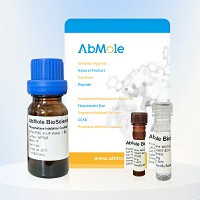All AbMole products are for research use only, cannot be used for human consumption.

In vitro: A key feature of atezolizumab is that it is FcγR-binding deficient, so it cannot bind to Fc receptors on phagocytes and therefore does not cause antibody-dependent cell-mediated cytotoxicity (ADCC). atezolizumab treatment could bring cytokine changes include transient increases in IL-18, IFNγ, and CXCL11, and a transient decrease in IL-6; cellular changes include increases in proliferating CD8+ T cells.
In vivo: By blocking the PD-L1/PD-1 immune checkpoint, atezolizumab reduces immunosuppressive signals found within the tumor microenvironement and consequently increases T cell mediated immunity against the tumor. The pharmacokinetics of atezolizumab were initially studied in cynomolgus monkeys and mice where its volume of distribution was calculated to be approximately that of the plasma volume. The in vivo biodistribution of atezolizumab 24 hours after infusion is, in order of magnitude, the spleen, lungs, kidneys, liver, heart, and muscle. In tumor bearing animals, the drug also accumulates intratumorally, initially at the pushing border of the tumor and progressing later to the tumor core, particularly if the tumor is necrotic. The pharmacokinetic curve of atezolizumab is dose-dependent (non-linear) because of target mediated drug disposition (binding of drug to the PD-L1 ligand in the body). Saturation of PD-L1 receptors by atezolizumab on circulating CD4 and CD8 T cells occurs between 24 and 48 hours after dosing with serum concentrations > 0.5 μg/mL. MPDL3280A binds to PD-L1 in monkey and human with comparable affinity between species.
In contrast, atezolizumab was able to interact with the mPD-L1, block the mPD-L1/hPD-L1 immune checkpoint in a cell-based assay, and provide inhibition of the growth of mouse tumors in a syngeneic mouse model, where the mPD-L1/mPD-1 immune checkpoint is present.
MW: 145 KD.

Acta Pharm Sin B. 2022 Aug 18.
Anti-PD-L1 antibody enhances curative effect of cryoablation via antibody-dependent cell-mediated cytotoxicity mediating PD-L1highCD11b+ cells elimination in hepatocellular carcinoma
Atezolizumab purchased from AbMole

J Control Release. 2022 Sep 22;351:255-271.
Reshaping hypoxia and silencing CD73 via biomimetic gelatin nanotherapeutics to boost immunotherapy
Atezolizumab purchased from AbMole

Cancer Res. 2021 Oct 1;81(19):5074-5088.
Epstein–Barr Virus–Encoded Circular RNA CircBART2. 2 Promotes Immune Escape of Nasopharyngeal Carcinoma by Regulating PD-L1
Atezolizumab purchased from AbMole
| Cell Experiment | |
|---|---|
| Cell lines | DCCIKs lymphocytes |
| Preparation method | The in vitro cytotoxicity of the DCCIKs used as effector cells in the absence or presence of 5 μg/mL MPDL3280A against CaSki cells employed as target cells at a ratio of 10:1, 30:1 and 90:1 was determined using a CCK8 kit. The effector and target cells were added to 96-well plates and incubated for 24 h. The groups comprising a mixture of cell types were the experimental groups, whereas the control groups contained only one cell type of the CaSki cells, DCCIKs or 1640 RPMI cultivating solution. The CCK8 assay was performed in triplicate and optical density (OD) was read at 570 nm. |
| Concentrations | 5 μg/mL |
| Incubation time | 24 h |
| Animal Experiment | |
|---|---|
| Animal models | Cynomolgus monkeys |
| Formulation | 20 mM his-acetate, 0.02% polysorbate 20, 240 mM sucrose, pH 5.5 |
| Dosages | 0.5, 5 and 20 mg/kg |
| Administration | i.v. |
| CAS Number | 1380723-44-3 |
| Form | Liquid |
| Storage | Store at -20°C or -70°C. Avoid multiple freeze-thaws. |
| Related PD-1/PD-L1 Products |
|---|
| PD-1/PD-L1-IN-9
PD-1/PD-L1-IN-9 is a potent and orally active inhibitor of PD-1/PD-L1 interaction, with an IC50 of 3.8 nM. PD-1/PD-L1-IN-9 can enhance the killing activity of tumor cells by immune cells. PD-1/PD-L1-IN-9 also exhibits significant in vivo antitumor activity in a CT26 mouse model. |
| NSC622608
NSC622608 is a V-domain Ig suppressor of T-cell activation (VISTA) ligand with an IC50 value of 4.8 μM. |
| PD-L1-IN-1
PD-L1-IN-1 is a potent PD-L1 inhibitor with an IC50 of 115 nM. |
| SL-279252
SL-279252 (PD1-Fc-OX40L) is a hexameric, bi-functional fusion protein with an ECD of PD-1 (70 pM affinity to PD-L1) linked to the ECD of OX40L (324 pM affinity for OX40) through an Fc linker. SL-279252 exhibited linear PK at doses up to 3.0 mg/kg, and a greater than proportional increase in AUC was observed at 6.0 mg/kg suggesting potential receptor saturation. The preliminary half-life is approximately 23 hours. |
| Rosnilimab
Rosnilimab is a novel PD-1 checkpoint agonist antibody that reduces overactive T cell inflammation. Rosnilimab optimizes PD-1+ T cell inhibitory signaling by enabling tight immune synapse formation. Rosnilimab restores immune balance bringing T cell composition to a less activated state. |
All AbMole products are for research use only, cannot be used for human consumption or veterinary use. We do not provide products or services to individuals. Please comply with the intended use and do not use AbMole products for any other purpose.


Products are for research use only. Not for human use. We do not sell to patients.
© Copyright 2010-2024 AbMole BioScience. All Rights Reserved.
